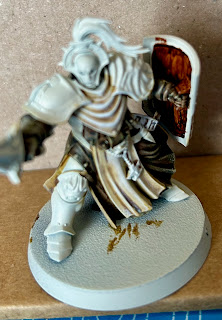The Need
Games Workshop's Boarding Actions supplement for Warhammer 40,000 is an excellent small-scale version of their main game. It includes cut-down lists for every faction which mitigates against the usual risk of skew that can occur in smaller points value games. However, they are sorely hindered by the requirement to buy (and build and paint) an expensive set of custom terrain that isn't much use for larger games of 40k.
Although there are 3rd-party alternatives for this terrain, including laser-cut patterns, they are not all that much cheaper thanks to the intricacy of the terrain components. To overcome this I've designed some simple 2D patterns that allow you to build the terrain layouts without the complications of large components. This takes advantage of the fact that the rules dictate that the terrain cannot be bypassed in any way: they cannot be climbed or flown over or seen over by any models. As a result, simple flat pieces can act like a map, indicating where movement and line-of-sight is possible and where it is not.
This also makes gameplay easier, as you can see exactly where everything is and it is easy to measure and move them.
 |
| Skitarii discover the cause of Facility Omega-4397's silence. |
The Design
Boarding actions terrain is composed of 1-inch square pillars separated by narrow bulkheads that are 72 mm long. These are laid out on a grid of squares, each 97 mm across. Why that size? Because then you can fit 12 squares across a typical 4-foot table (once you subtract an extra half-inch on each end for the end columns).
So my columns are 1-inch squares, with 2 mm radius corners. And I've decided to use magnets to connect them together; because the MDF will be 3mm thick, these will be 3⌀ x 2 mm magnets. Therefore, I've cut out 3 mm wide by 2 mm deep notches on three sides to accommodate them. (There are no four-way connections needed.)
The walls are 7 mm thick at the ends, wide enough for their own magnets, but with a 5 mm waist, mostly just for interest, but also to allow them to be used for a hatchway in a pinch. Speaking of which, the hatchways are centred in their bulkheads and about 30 mm wide. The 5 mm waist lets you easily judge where the edge of the hatchway is in order to adjudicate line-of-sight.
In addition, there's a circle cut into each hatchway to hold a magnet which will connect to the magnet in their corresponding hatch. Hatches are just simple 7 mm diameter hinges with 30 mm wide hatches, again with a circle cut in the hinge to hold a magnet. These hatches simply clip to the top surface of the hatchway and can pivot on their magnets to indicate them being opened or closed.
All components are connected to the frame by half-mm gates. I wasn't sure how thick these would need to be; they had to be thick enough to not have the pieces fall out early but thin enough to be able to punch them out easily. As it turns out, the half-mm gates were good, with a couple of pieces coming loose during preparation but otherwise holding together and then punching out in a quite satisfying way!
Here are the Thingiverse files for download if you want to try for yourself.
The Build
The print was nice and clean. There are lots of little negative-space pieces: the magnet holes, rounded pillar corners and hatchway waists. They can be pushed out easily with the help of something pointy. And I found the waist sticks useful for applying glue in the next step.
 |
| Freshly printed in 3mm MDF with negative-space pieces removed and magnets ready. |
The hatch and hatchway magnets can be glued in while everything is still on the frame. It was quite tricky to position them so their 2mm thickness would sit in the middle of the 3mm thick MDF. It would probably be easier if 3⌀ x 3 mm magnets were used. I just used ordinary PVA glue: not ideal for gluing metal, but much easier to work with and clean up than anything else.
 |
| Now with hatch and hatchway magnets added, ready for undercoating. |
I had intended to glue the other magnets in on the frame, too. But it was difficult enough getting the hatchway magnets in place without them attracting each other out of position, so I ended up gluing them into place after punching the pillars and bulkheads out. Still a tricky job, but much easier.
Before that, however, I undercoated the whole lot with Leadbelcher spray, then sponged on Skrag Brown to give them a rusty texture. Then, to make the hatchways more visually distinctive, I painted them yellow (over an off-white undercoat). One advantage of designing your own builds is you can build things like stencils measured out precisely to suit the design. I've done this for some nice hazard stripes for the hatchways, simply cut with a sharp scalpel from standard printer paper, then sprayed black.
 |
| Hatchways with yellow waists painted |
 |
| Hazard stripe stencil (printer paper) and applied stripes. |
The Layout
I tested out the build with the first map, "Access Junction Primus". Although Games Workshop's set comes with a gridded pair of boards to set everything out on, it was easy enough to lay everything out on an open board. Helped by the fact that my board is exactly 4 feet across, and a little care measuring separation of the components, it all came together nicely and the magnets work very well to hold everything in place. I'll cut out some 97 mm square vinyl markers to demarcate the entry zones.
 |
| Overview of "Access Junction Primus" |



















